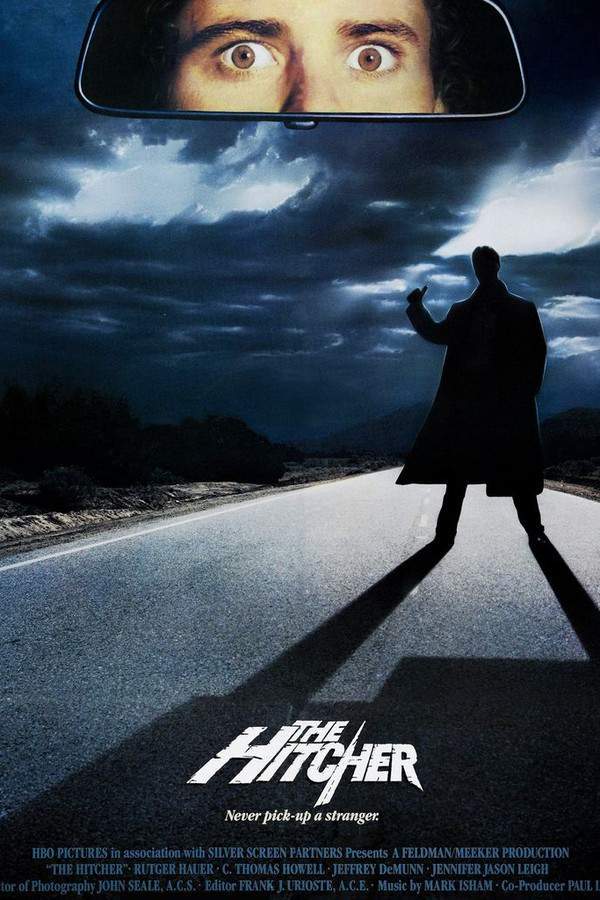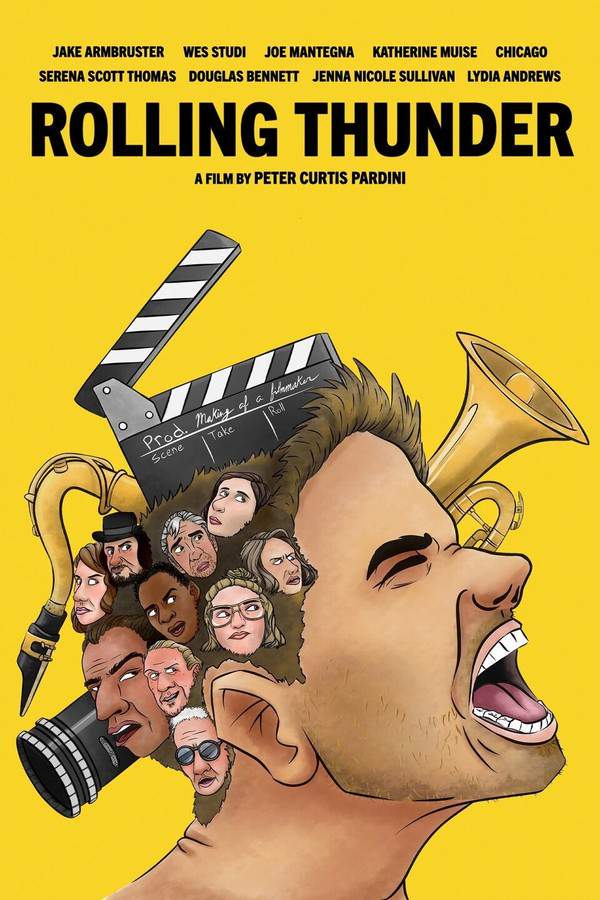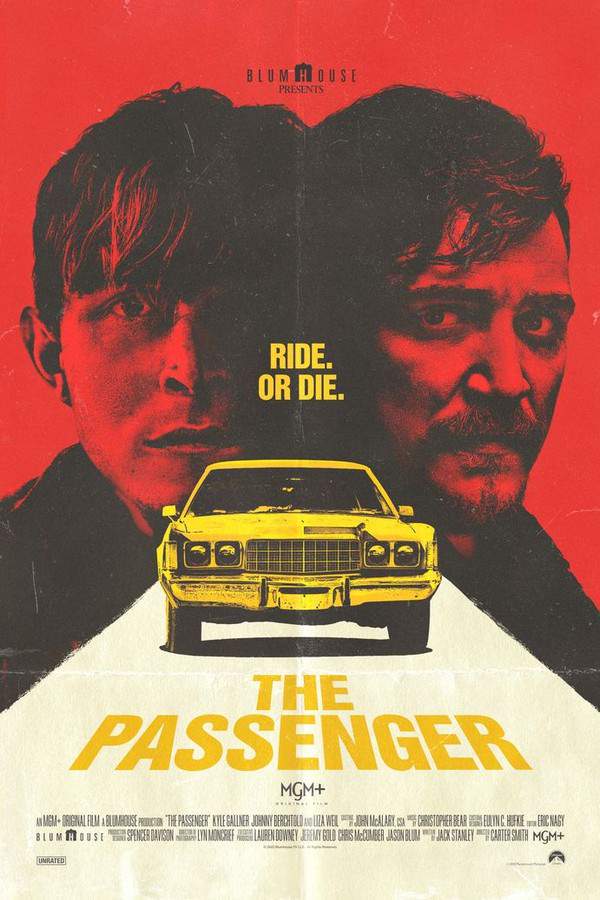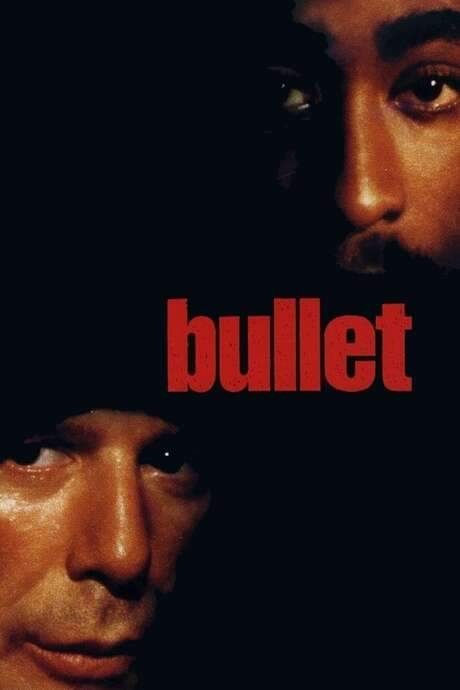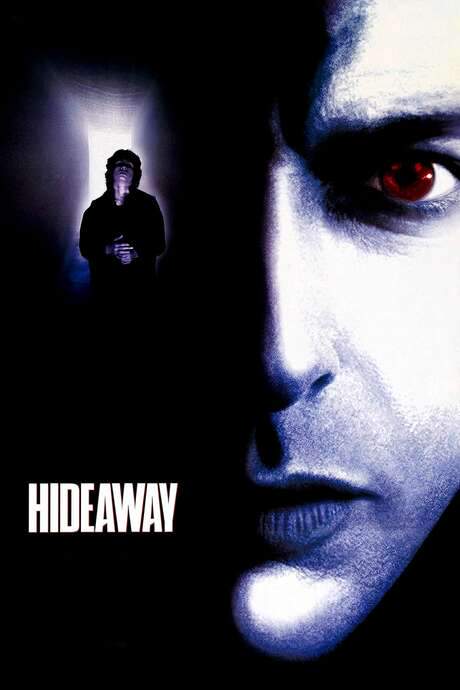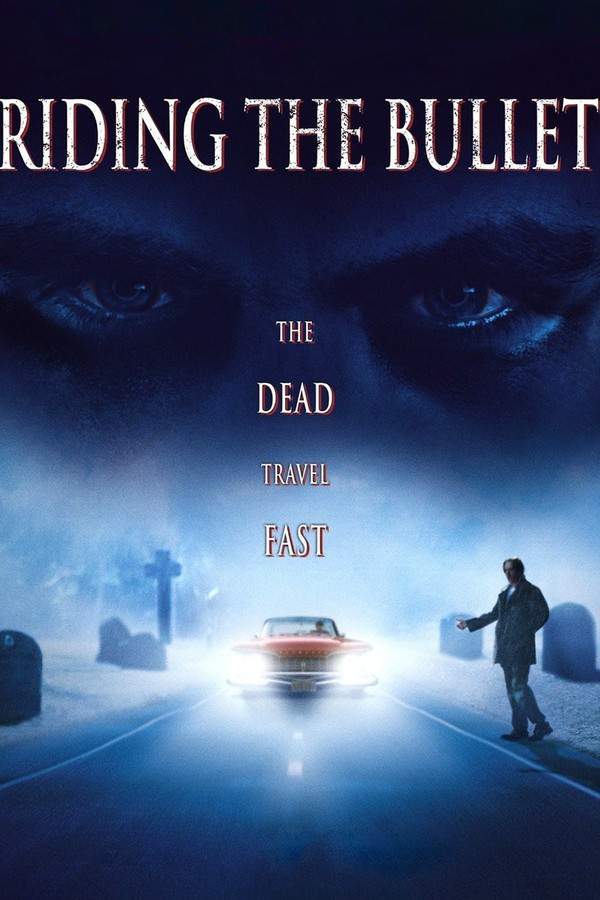
Riding the Bullet 2004
Directed by

Mick Garris
Made by

Innovation Film Group (IFG)
Test your knowledge of Riding the Bullet with our quiz!
Riding the Bullet Plot Summary
Read the complete plot summary and ending explained for Riding the Bullet (2004). From turning points to emotional moments, uncover what really happened and why it matters.
In the autumn of 1969, we meet Alan Parker, a student at the University of Maine, who finds himself mired in a complex tapestry of existential dread and emotional turmoil. His professor has observed an unsettling obsession with death in Alan’s artistic expressions. On his birthday, October 30th, Alan grows increasingly convinced that his girlfriend, Jessica, is intent on severing their relationship. As darkness envelops the day, Alan retreats into the sanctuary of his bathtub, where cannabis clouds his thoughts, leading to a spiral into suicidal ideation.
It is at this low point that the Grim Reaper appears, a chilling embodiment of death, who whispers temptations of despair into his ear. The murals surrounding him ominously reflect faces that seem to echo the Reaper’s sinister calls, intensifying Alan’s inner chaos. Just as he succumbs to the suffocating darkness, Jessica and a group of friends burst in, surprising him with a jubilant birthday celebration, which ironically culminates in a moment of accidental self-harm.
Upon regaining consciousness in a hospital bed, Alan is confronted by Jessica, whose feelings of anger and concern mingle with an unwavering declaration of love. In a bid to console him, she gifts him tickets to a John Lennon concert in Toronto, Canada. However, this glimmer of hope fades quickly as the Grim Reaper continues to shadow his every thought.
The following day, after being discharged, Alan is faced with Jessica’s stark revelation about the emotional barrier he has erected, which protects him but also alienates her from his true self. This insight is abruptly overshadowed by a distressing phone call: his mother, Jean, has suffered a stroke. With a heavy heart, Alan decides to return home to Lewiston, Maine, selflessly giving his concert tickets to his roommates.
His journey back to his hometown dredges up memories of his father’s funeral from when he was just six. Alan is haunted by visions of his mother’s demise and the sorrow of Jessica mourning at his grave. The trip takes an unexpected dire turn when he is offered a ride by Ferris, an army deserter, in his Volkswagen van.
What ensues is a harrowing near-miss as they barely escape a head-on collision, crashing into a ditch instead. Shaken but unscathed, Alan navigates this brush with death, which ignites a hallucinatory journey, blurring the lines between the living and the deceased.
In this dreamlike reality, Alan encounters vibrant apparitions that transcend life. A billboard advertising “Ride The Bullet” revives lost memories of a long-ago visit with his mother, where they both hesitated to ride the attraction. His surreal voyage leads him through a cemetery, where the grave of George Staub, who passed away two years prior, catches his eye.
As Alan’s grasp on reality begins to slip, he is confronted by a ghostly version of himself, which brings forth a chilling warning: a place awaits him if he ignores these signs. Accompanied by this spectral doppelganger, they are whisked away by George Staub, whose unsettling scent of formaldehyde sends a chill down Alan’s spine.
While traversing winding roads, Alan’s spectral companion nudges him to recall a cryptic phrase from a forgotten book: > “The dead travel fast.” Despite Alan’s silence, his discomfort grows as he and George delve into conversation about Thrill Village and the infamous ride. In a moment of desperation, Alan fabricates a tale of his conquests on the attraction, only for George’s knowing gaze to expose his deception.
The conversation darkens as George reveals his own tragic fate: decapitation in a horrific car accident. Adding to the weight of this revelation, George poses a harrowing dilemma: Alan must decide who accompanies him to the afterlife—his mother or himself. The inability to choose could result in both facing an eternal fate together, leaving Alan caught in a storm of fear and uncertainty.
In a moment of panic, Alan chooses his mother for the afterlife, only to be violently expelled from George’s vehicle as if he were a piece of refuse. When he comes to in the cemetery, he hastily seeks another means to return, arriving at the hospital just as his mother succumbs to a heart attack while watching television.
As Alan grapples with the twilight of his existence, he finds his life fractured—divorced from Jessica and struggling to survive as an artist. Despite the ravages of time, his creative spirit perseveres, kindled by a passion for painting. A visit to Thrill Village brings him full circle, as he finally gathers the courage to confront his fears and ride “The Bullet,” a potent reminder that some truths are best left unspoken.
Riding the Bullet Timeline
Follow the complete movie timeline of Riding the Bullet (2004) with every major event in chronological order. Great for understanding complex plots and story progression.
Alan's Existential Struggle
In the autumn of 1969, Alan Parker, a university student, begins to grapple with profound feelings of existential dread and emotional turmoil. His artistic expressions become increasingly fixated on themes of death, raising concerns from his professor about his mental state.
Birthday Doubts
On October 30th, Alan fears that his girlfriend, Jessica, intends to end their relationship. Consumed by anxiety on his birthday, he isolates himself in the bathtub, using cannabis to numb his spiraling thoughts of despair and suicidal ideation.
Encounter with the Grim Reaper
As Alan sinks deeper into darkness, he is visited by the Grim Reaper, an eerie figure embodying death. The Reaper whispers temptations of despair into his ear, heightening Alan's feelings of chaos and hopelessness.
Surprise Birthday Party
Just as Alan reaches his breaking point, Jessica and his friends burst into the bathroom, throwing a surprise birthday celebration. However, the moment takes a tragic turn as Alan accidentally hurts himself amid the chaos.
Hospital Awakening
Alan regains consciousness in a hospital bed, where he is met with Jessica's mix of anger and genuine concern. She tells him of her love and gives him tickets to a John Lennon concert, hopeful for a rekindling of their relationship.
The Weight of Emotional Barriers
After being discharged from the hospital, Jessica confronts Alan about the emotional barriers he has built. She expresses how this wall has distanced him from her, leaving Alan conflicted and in deep contemplation.
Bad News from Home
Alan receives tragic news: his mother, Jean, has suffered a stroke. With a heavy heart, he decides to return home to Lewiston, Maine, giving his concert tickets to his roommates as a selfless gesture.
Haunting Memories
As Alan returns to his hometown, memories of his father's funeral resurface, conjuring images of his mother's eventual demise. These thoughts plague him as he feels the weight of grief and mortality hanging over him.
Near-Death Experience
On his journey, Alan is involved in a harrowing near-miss accident when he hitchhikes with Ferris, an army deserter. They barely escape a head-on collision but crash into a ditch, igniting Alan's fears of death.
Hallucinatory Journey Begins
Following the accident, Alan embarks on a hallucinatory journey that blurs the lines between life and death. He encounters vibrant apparitions and memories associated with his mother's love, reflecting on past family moments.
Confrontation with Ghostly Self
In this dreamlike state, Alan encounters a ghostly version of himself who warns him about ignoring the signs of his impending fate. The apparition leads him to a grave and reminds him of the fragile nature of life.
Tragic Dilemma
Alan learns of George Staub's tragic decapitation in a car accident, leading to a haunting choice: who should accompany him to the afterlife? His inability to choose raises a storm of fear and uncertainty within him.
Escaping the Dilemma
In a moment of panic, Alan chooses his mother to accompany him in death, resulting in a violent expulsion from George's vehicle. This tumultuous moment sends Alan back to reality, leaving him grappling with his choices.
Final Loss
Alan rushes to the hospital, only to find his mother succumbing to a heart attack while watching television. This devastation leaves Alan fractured and lost, mourning the loss of his last family connection.
Confronting Fears at Thrill Village
Years later, Alan arrives at Thrill Village, the site of his childhood memories, hoping to reclaim his lost courage. He decides to confront his fears by riding 'The Bullet,' symbolizing his acceptance of life's profound truths.
Riding the Bullet Characters
Explore all characters from Riding the Bullet (2004). Get detailed profiles with their roles, arcs, and key relationships explained.
Alan Parker
Alan Parker is a troubled student riddled with existential dread and emotional turmoil. His journey reflects a complex interplay of fear, grief, and the struggle to find meaning in life amid a cascade of familial loss. Haunted by memories and pressured by his artistic expression, Alan's character is multifaceted, showcasing vulnerability and resilience.
Jessica
Jessica is Alan's girlfriend, characterized by her unwavering love and concern for him. Her emotions oscillate between anger and deep affection, highlighting the strain that Alan's mental state places on their relationship. Jessica serves as a pivotal figure in Alan's life, representing hope and the possibility of healing amid darkness.
George Staub
George Staub is a ghostly figure representing the past and the consequences of life's choices. His tragic fate warns Alan of the potential outcomes of his current path, serving as a haunting reminder of mortality. Through their conversations, George embodies the darker side of the life-and-death struggles Alan faces.
Riding the Bullet Settings
Learn where and when Riding the Bullet (2004) takes place. Explore the film’s settings, era, and how they shape the narrative.
Time period
Autumn of 1969
The story unfolds during the autumn of 1969, a time marked by societal upheaval and counterculture movements. This period was characterized by existential questioning, particularly among the youth, influenced by changing cultural values and increased awareness of mental health issues. It mirrors Alan's personal struggles with identity and the concept of mortality.
Location
University of Maine, Lewiston, Maine, Toronto, Canada, Thrill Village
The film takes place in various locations, primarily the University of Maine, where the protagonist grapples with his existential fears. Lewiston is his hometown, evoking memories of loss and family. Toronto serves as a backdrop for an important concert event, while Thrill Village symbolizes both childhood nostalgia and the confrontation of one's fears.
Riding the Bullet Themes
Discover the main themes in Riding the Bullet (2004). Analyze the deeper meanings, emotional layers, and social commentary behind the film.
💔
Loss and Grief
At its core, the film explores themes of loss and grief, both personal and familial. Alan's journey is steeped in the fear of losing his loved ones, echoing his traumatic memories of his father's funeral and his mother's stroke. This theme illuminates the emotional weight that shapes his actions and decisions throughout the narrative.
🌌
Existentialism
The film delves deeply into existential themes, showcasing Alan's confrontation with death and the inherent meaning of life. His hallucinations and encounters with the Grim Reaper signify a profound internal struggle. The narrative poses philosophical questions about existence, purpose, and the nature of reality, reflecting Alan's intense emotional turmoil.
💡
Self-Discovery
Alan's journey symbolizes a path to self-discovery amidst chaos. Throughout the film, he grapples with his emotional barriers, leading to significant realizations about love and vulnerability. This theme emphasizes the importance of confronting one's fears and acknowledges that personal growth often arises from confronting painful truths.

Coming soon on iOS and Android
The Plot Explained Mobile App
From blockbusters to hidden gems — dive into movie stories anytime, anywhere. Save your favorites, discover plots faster, and never miss a twist again.
Sign up to be the first to know when we launch. Your email stays private — always.
Riding the Bullet Spoiler-Free Summary
Discover the spoiler-free summary of Riding the Bullet (2004). Get a concise overview without any spoilers.
In the quiet, mist‑laden towns of New England, a young artist wrestles with the sudden loss of his father while his mother’s health hangs by a thread. The world feels both familiar and oddly off‑kilter, a place where ordinary streets whisper of unseen currents and every shadow seems to hold a secret. The film’s tone drifts between introspective melancholy and a subtle, unsettling unease, inviting the audience to linger on moments that feel both grounded and slightly surreal.
Alan Parker, an art student haunted by the specter of mortality, finds his creative impulses tangled with an obsessive need to understand what lies beyond life’s fragile veneer. His journey, prompted by a desire to be near his ailing mother, becomes a pilgrimage through a landscape populated by strangers whose presence hints at something far larger than ordinary coincidence. The atmospheric backdrop—a blend of autumnal decay, dimly lit diners, and the faint hum of an old amusement park—mirrors Alan’s internal turbulence, making the external world a reflection of his inner doubts.
Along the road, Alan encounters a series of enigmatic figures, the most intriguing of whom is the reclusive George Staub. Staub’s unsettling demeanor and lingering scent of formaldehyde suggest that the boundaries between the living and the dead are thinner than they appear. Their interactions are charged with a quiet, almost palpable tension, hinting at supernatural undercurrents that challenge Alan’s perceptions and force him to confront questions he has long avoided.
The film folds these threads into a meditation on grief, artistic obsession, and the uneasy dance between reality and the unknown. It asks whether the journey toward acceptance is charted by the roads we travel or by the shadows that follow us, leaving viewers with a lingering sense of curiosity about how far Alan will go before the bullet of truth finally finds its mark.
Can’t find your movie? Request a summary here.
Movies with Similar Twists and Themes
Uncover films that echo the narrative beats, emotional arcs, or dramatic twists of the one you're exploring. These recommendations are handpicked based on story depth, thematic resonance, and spoiler-worthy moments — perfect for fans who crave more of the same intrigue.
Featured on this page

What's After the Movie?
Not sure whether to stay after the credits? Find out!
Explore Our Movie Platform
New Movie Releases (2025)
Famous Movie Actors
Top Film Production Studios
Movie Plot Summaries & Endings
Major Movie Awards & Winners
Best Concert Films & Music Documentaries
Movie Collections and Curated Lists
© 2025 What's After the Movie. All rights reserved.




